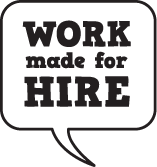Anchors away!
Shout out if any of this sounds familiar:
A client you’ve been wanting to work with for a while now emails you asking if you’re available to do some work. He’s heard about you through a friend of a friend, seen some of your stuff on line and hears you can turn projects around pretty quickly. He tells you that if the first few pieces work, he’ll likely have a lot more work next month. You do some quick math and decide to offer him your friend rate; you’ll make up whatever you lose on this project next month.
You knock out the project like a rock star, turn it around with time to spare and thrill the client. He calls three weeks later with more work, but balks when you quote him your going rate, “Man, three weeks ago it was 30% cheaper for more work; there’s no way I’m paying that much for this job.”
You’re pissed, he’s pissed and no one has what they want. You traipse off to the corner bar/coffee shop and bitch to your friends about the pain-in-ass that is freelancing.
What the heck happened?
You anchored without realizing it.
Huh?
When you are the first person to name a price in negotiations you “anchor” the price. If you are the seller and you anchor, you set the highest value the price will reach; if you are the buyer and you anchor, the price won’t go below the number you name.
There is nothing inherently wrong with anchoring, but if you do it without explaining your number, or without doing your homework, you can turn a potentially great client relationship into a contentious haggling affair where everyone walks away unhappy.
I’ll talk about the benefits and detriments of anchoring in future posts, but for right now, I want to focus on the importance of communicating your price to a client. Providing information to a client about why your rate is your rate is the single easiest way of making money, but because we tend to think of talking about money as impolite, a lot of folks throw a number out to a client, hope it sticks and then adjusts their working schedule to juggle all of the client’s demands.
There is a better way, and while it can require a bit of extra footwork, it will also help you manage your clients’ expectations, avoid some common billing disputes, and turn new clients into loyal clients. Interested?
Then just send $19.95 and a self-addressed, stamped envelope to….
kidding.
Take out a sheet of paper. Write your current hourly rate at the top. Write the word “Pissed” and underline it; underneath it, list everything that has pissed you off about rate or billing disputes related to your freelance work in the last 12 months. Everything.
Done? No? Ok, keep going.
Now? Good. Now write the word “Pleased” and underline it. List everything that made you want to work harder for someone in the last 12 months, or made you want to give someone a discount, of any kind.
Feel better? Good. Because you just did 70% of the work to create your very first rate sheet.
Your rate is the price at the top of the page. Everything under the “Pissed” column is what can increase that rate; everything in the “Pleased” column has the potential to decrease it. Assign rates, in dollars or percentages, to each of the items you’ve listed. Last minute request? 15% increase. First time client? 10% discount. Request for work when your workload is already packed full? $125 premium for the first 2 days; $75/day thereafter.
(Don’t use my numbers; I don’t do freelance work. Talk to other freelancers and figure out what’s fair for your experience and the type of work you do. I hear this is a good starting point.)
This rate sheet is the first thing you email a client when they inquire about a potential job. Number 1. First. At the beginning. BEFORE the work. Before.
You might not want to list everything you just wrote on they rate sheet you provide clients, but you do want to explain to a client before you accept a job or additional requests what is most likely to impact the price.
So, Mr. Client from before? Return email with a the rate sheet attached: “Hey, I’d love to work with you and I think this project will be a great fit. I have some time to take this on and I should be able to meet your deadlines without a problem. I’ve attached my rate sheet, which explains what factors can impact pricing. Based on what you’ve told me, I estimate this will be about 12 hours of work. Because you’re a new client and because you think there is the potential for additional work, I’ll give you a 30% discount on my normal rate. Feel free to call if you have any questions.”
He knows he’s getting a discount, knows what to expect from you in the future and feels special. Score.
Categories: Negotiation Strategy




This is a fantastic article and a great concept for a blog–I’m starving for this kind of advice! Can’t wait to see what other contracting stuff you tackle.
Excellent advice! Pricing is something I struggle with both as a freelance artist and with my company.
this might one of the best explanations of how to set a freelance rate i’ve read! yay!
OOO! I have a request for a future topic– “Mission Creep” (this was very good, by the way.)
THANK YOU!
Thanks for this article — I look forward to reading and learning more. If it’s possible, can you add an RSS feed so folks can subscribe and not miss a post?
Again, thanks!
A fine idea, Jim; thanks. I’ll futz around with it this weekend. If that doesn’t work, would you be interested in a tin can with string attached?here’s the link, I’ll make it fancier and on the front page soon: http://workmadeforhire.wordpress.com/feed/
I have subscribed. Thanks! (Though I think the site needs a name now…it shows up in the feed as the URL. No worries on my end, but you may want something more descriptive.)
I’ll put my tin cans and string back in the recycling bins.
Thanks again!